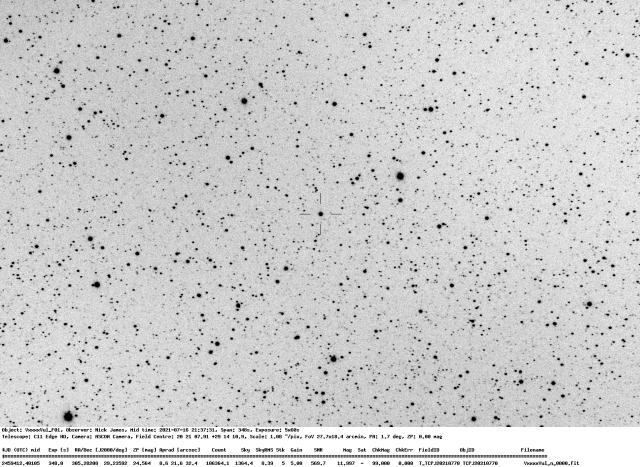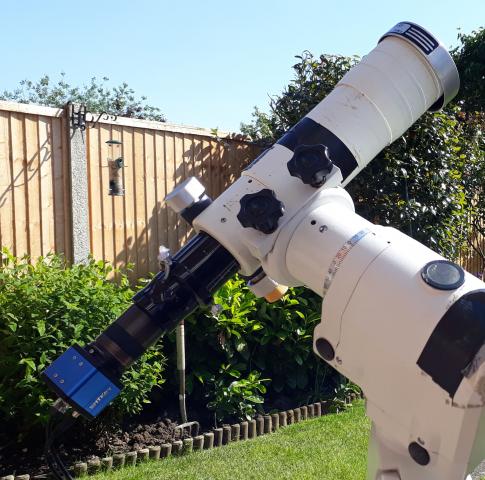Forum Replies Created
-
AuthorPosts
-
 Nick JamesParticipant
Nick JamesParticipantYes, it looks to be at the bottom of a cycle.
 Nick JamesParticipant
Nick JamesParticipantHere’s the field. I get it around mag 12 (unfiltered re Gaia G) and a position of 20:21:07.71 +29:14:08.9 (Gaia DR2).

 Nick JamesParticipant
Nick JamesParticipantMy last observation was on July 7.9 at 16.52. It’s in the BAA database. Richard Sargent also got some observations later that night at around 16.10. They are in the database too.
 Nick JamesParticipant
Nick JamesParticipantI have a ten year old APC UPS in my observatory and it is on permanently, but so is the observatory PC that it powers and a few other cameras and sensors. They are designed to be on permanently but, like all electrical things, don’t like getting damp.
 Nick JamesParticipant
Nick JamesParticipantDaryl – There are certainly a lot more trails on my images this summer compared to previous years. For imagers the way that you stack subframes can help to a certain extent. The animated GIF attached is the same frame stacked as average and as sigma clip. There are 5 satellite trails on this image, two bright ones and three faint. The sigma clip stack definitely suppresses the bright ones. Photometrically the two stacks are the same.
 Nick JamesParticipant
Nick JamesParticipantCBET 4977 has designated this nova as V1674 Her.
 Nick JamesParticipant
Nick JamesParticipantI’ve just measured it as 7.54 (2021 June 13 22:51) compared to 5.94 at this time last night. Both unfiltered ref to Gaia DR2 G so somewhere between V and R. That’s a fall of 1.6 mags in day. That’s pretty fast. I remember photographing V838 Her (George Alcock’s last nova) in 1991 but only getting it on one occasion since it faded so fast.
 Nick JamesParticipant
Nick JamesParticipantAnother bright nova! Here’s my image https://britastro.org/observations/observation.php?id=20210612_231222_b0ed29be83050b55. I’ve taken some 1s exposures too which I’ll measure later.
 Nick JamesParticipant
Nick JamesParticipantHere are my edited highlights from yeasterday: https://youtu.be/MoRfhjLTS8k. From Chelmsford I managed about 15 mins at the beginning and end but it was cloudy for the rest of the time.
 Nick JamesParticipant
Nick JamesParticipantI too have ordered a copy. Tom’s unsolicited email campaign is clearly working! I wonder if the plot includes a hero who drives his car at supersonic speeds but is shopped to the local feds by a trusted colleague?
 Nick JamesParticipant
Nick JamesParticipantGary. Aren’t you at the ground? I was looking forward to an eclipse drawing from the posh stand at Edgbaston.
 Nick JamesParticipant
Nick JamesParticipantVery cloudy in Chelmsford at the moment after a cloudless day yesterday. Weather satellite shows it clear at the moment up the east coast and in the North Sea and a few clear patches elsewhere. Fingers crossed for some breaks later.
 Nick JamesParticipant
Nick JamesParticipantThis is the link for my eclipse livestream on Thursday morning https://youtu.be/DtqzzB5xAF8. The forecast for here looks encouraging at the moment.
 Nick JamesParticipant
Nick JamesParticipantHere is a speeded up video of your flares from Chelmsford. I have lots of cheap IP cameras pointing in all directions recording video in a 7-day cycle so I still had this from Sunday morning. There is quite of lot of cloud but Altair is visible just left of centre and Delphinus is visible through the cloud. I’m around 37 miles SW of you as the crow flies so my flares were probably not as impressive as yours.
 Nick JamesParticipant
Nick JamesParticipantThis is the set-up I’m using for the live stream. It is a Megrez 72 FD refractor on a NEQ6 with an IP camera module which feeds video directly into OBS via a long PoE Ethernet cable and then on to Youtube. It’s the first time I’ve tried this and it was far too easy! Hopefully the weather will play ball on Thursday.
 28 May 2021 at 9:34 pm in reply to: Introducing MetroPSF – a program for ensemble photometry #584272
28 May 2021 at 9:34 pm in reply to: Introducing MetroPSF – a program for ensemble photometry #584272 Nick JamesParticipant
Nick JamesParticipantHere is an example file which gives the JD zero date: http://www.nickdjames.com/Transfers/ngc6888_n_solved.fit.gz
26 May 2021 at 10:26 pm in reply to: Introducing MetroPSF – a program for ensemble photometry #584265 Nick JamesParticipant
Nick JamesParticipantMax, Thanks. That works and this looks really powerful, particularly the ability to measure multiple variables in a field and generate automatic reports. My only remaining comment is that I get strange timestamps:
ES UMa, -4713-11-24 12:00:00.000 UTC, G = 10.91 ± 0.11
-4713 is something like JD = 0. The FITS file I’m measuring includes the record:
DATE-OBS= ‘2021-05-25T22:53:18’ / Start time of stacked exposure
Nick.
26 May 2021 at 7:25 pm in reply to: Introducing MetroPSF – a program for ensemble photometry #584263 Nick JamesParticipant
Nick JamesParticipantHi Max,
I’ve downloaded 0.15 and am running it under Windows 10. It does the PSF photometry but then fails when I try to download catalogue stars:
694 ‘charmap’ codec can’t encode character ‘u03b1’ in position 25: character maps to <undefined>
Any idea what this might be?
Nick.
 Nick JamesParticipant
Nick JamesParticipantMaxim,
Just to let you know that I’ve been using the program but haven’t had a chance to look at the SNR details yet. I’ll do that when I get time.
Nick.
 Nick JamesParticipant
Nick JamesParticipantThis comet is now quite a nice target for small, widefield instruments. I imaged it with a 90mm refractor last night.
-
AuthorPosts
